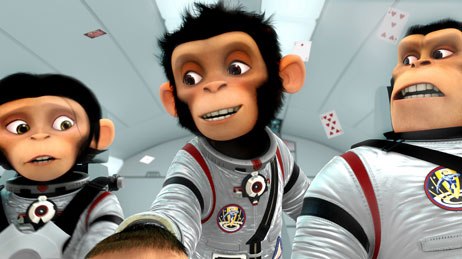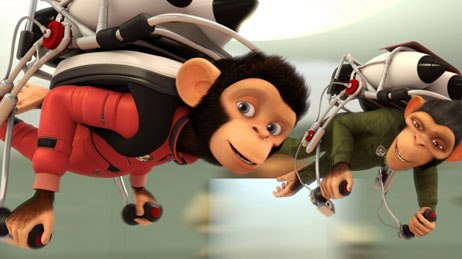Writer/director Kirk De Micco and Producer John H. Williams talk about the making of the sci-fi spoof with the right stuff.
"We're on the same page in the program book as Confessions of a Porn Addict."
That's the risk a writer-director takes when he brings his G-rated animated family film to an adult comedy film festival. Kirk De Micco is in his Montreal hotel room preparing for the following night's screening of his film Space Chimps at the film sidebar to the city's annual Just for Laughs festival.
While it's not quite as lengthy a journey as his film's simian heroes take, De Micco's odyssey in turning his 2002 concept into a finished work is an adventure in its own right. It began with a viewing of The Right Stuff, Philip Kaufman's classic 1983 movie, based on Tom Wolfe's book of the same name, that looked at the original Mercury space program. A line from the film stuck in De Micco's head: "Does a monkey know he's sitting on top of a rocket that might explode?"
"I was like, 'Well, what if he did?'" De Micco recalls of his lightbulb-switching-on moment. He found a copy of the 1961 Life magazine that featured Ham, the original space chimp, on its cover, looking quite serene --if not downright smug -- and brought both the magazine and the idea to producer John H. Williams' Vanguard Animation. "I immediately thought it was a good pitch," says Williams. "A chimp with the wrong stuff being sent on a dangerous deep space mission. It seemed like a totally winning idea, and we started developing it from there."
Like any high-concept premise, what would eventually be released as Space Chimps evolved as it moved forward. "I originally pitched the project to John as a Tommy Boy conceit," De Micco explains, "the ne'er-do-well grandson of someone great who has to live up to his grandfather's legacy. We were playing a bit on The Right Stuff, but knowing it would be a send-up of the whole sci-fi genre, not unlike what Shrek did with fairy tales."
Genre parody is familiar territory for Williams, the producer of Shrek and Shrek 2, and executive producer of Shrek the Third. He and De Micco were already developing Roald Dahl's The Twits for film, with De Micco co-writing the screenplay with John Cleese. Williams and De Micco began refining the concept, soon joined by producer/director Barry Sonnenfeld, with whom De Micco had also worked on another planned adaptation, Elmore Leonard's children's book Coyote in the House. (Sonnenfeld would eventually become one of Space Chimps' producers.)
De Micco explains that "John's input was what the tone of [the film's] world was and the type of comedy he wanted to achieve. Barry brought in his own tone of how to do comedy with the characters." De Micco goes on to describe Space Chimps as the Airplane! of sci-fi movies. "It's a fun thing to do. We want to make sure we're still doing a great sci-fi adventure for kids who won't get any of the references, even if their parents are laughing at the film's Star Trek jokes."
However much the film spoofs the genre, De Micco says that they tried "to keep things so that you really care about the world and the hero's journey; if he's joking or mugging, it's not as engaging. It's similar to what Barry did in Get Shorty or Men in Black. Patrick Warburton's and Sheryl Hines' characters (the straitlaced monkeys accompanying wiseguy Ham III, voiced by Andy Samberg) really believe they're doing the right thing."
De Micco says the film's touchstone is Star Wars' famous cantina scene. "I remember watching that scene, loving the atmosphere and the music and thinking, 'I don't want to leave the cantina, I want to hang out in here and chill with these guys.' What if the cantina was the entire planet, what if monsters were running the planet -- and one of them was the villain?"
With animation writing credits going back to 1998's Quest for Camelot and 2005's live-action/CGI Racing Stripes, De Micco had a fairly substantial grounding in the tools of the medium. "I always thought [animation] was written by guys who draw, who do storyboarding, etc. I can't draw a stick figure. When I started doing animation, I became totally enamored with the process. Writing is very solitary, so doing animation was a great opportunity to work with artists and write all day. Even as a writer, I felt like I was part of the process. I was always a huge fan, just never thought I could do it, but from the first time I worked in animation, I said to myself, 'that's where I want to be.'
"John gave me the opportunity [to direct Space Chimps]. After [my having worked] with him on three other scripts, he felt I could do the job. It was a learning process, but I've done things like Racing Stripes, where there were animated characters. Storyboarding is obviously a huge part of the process -- I just think of it as having more writers, but they have a larger talent than I have.
"The difference between live-action and animation is that in animation you get to be little bit of a writer, editor, director and producer all at once. It's the same for a lot of roles in animation -- we're all working on the same thing at the same time. It's not like live action, where the director takes it away from the writer, shoots and then puts it in editorial. In live action, you might shoot in one country and edit in another -- nobody gets to know each other when you work that way."
Neither De Micco nor Williams harbors any illusions that Space Chimps will be mistaken for a Pixar or DreamWorks film. "We're making our films at 25% of their cost," Williams notes, "on a two-year production cycle with 170 people vs. over 500 people at DreamWorks or Disney/Pixar." According to the IMDB website, the difference is even greater, with Space Chimps' $37 million budget only 20% of WALL•E's $180 million. Williams points to a "consortium of partners" who've invested in Vanguard's productions, including its previous CGI effort Happily N'Ever After. "They've stayed with us and continue to invest in our movies, foreign partners being the foundation of that. The tax incentives in a lot of different states and countries are very good right now.
"There are a lot of alternatives out there," Williams continues, "but we wanted to build our own pipeline -- we created a team and pipeline for this movie," as well as a studio in Canada's animation capital, Vancouver, British Columbia. With Chimps now in release, Vanguard's temporarily closed the facility until the studio's next project can be launched. "We hope to get our production up to one picture a year, but we haven't hit that mark yet."
Vanguard's first effort was 2005's Valiant, a fanciful account of British carrier pigeons that help the allies win World War II. The film was released by Disney during the period when it looked like the Mouse House and Pixar would be going their separate ways. "We were right there in the midst of that time," reflects Williams. "Disney was doing The Wild and Chicken Little on their own; I think The Wild cost $80 million and Chicken Little over $100 million. We presented the low-cost alternative to that -- our total budget was below $40 million. We had very significant support from the U.K., both in equity and from U.K. Film Council.
"Afterwards, Disney bought Pixar, which was a great thing and re-established them as a huge success with a great animation partner." With Chimps a 20th Century Fox Release, and N'Ever After distributed by Lions Gate, Williams says he'd "love for us to have a steady studio distribution arrangement. We've consistently been able to finance our films outside of the normal studio development and production process. I think we'd make for an ideal animation partner for a number of the studios -- hopefully Space Chimps will precipitate that interest."

Chimps' tight budget led to some fortuitous choices, including the incorporation of sound by Blue Man Group into the film's score.
De Micco points out how Chimps' tight budget led to some fortuitous choices -- for example, with regard to the music -- that he says ultimately made for a better picture. "It was Chris Bacon's first [score] after doing orchestrations for James Newton Howard on Men in Black, all that kind of stuff. In fact Howard suggested him to us. Chris had also worked with the Blue Man Group -- who wound up doing a lot of music on our score. They would do stuff in New York City with all their PVC pipes and send us beds, which we'd combine with our big orchestra. It gave us a really unique sound. We might not have tried to be creative that way if we had the big bucks to just hire the most expensive composer."
With Space Chimps a done deal, De Micco is continuing work on his next animated project, a caveman comedy at DreamWorks called Crood Awakening that will be directed by Chris Sanders of Lilo & Stitch fame. "I wrote the first script with John Cleese. It was originally going to be an Aardman project, but they kept it at DreamWorks after their split with Aardman. Chris came on a year ago and we're just plowing ahead. We're talking about a 2011 release."
When it comes to the eternal 2D vs. CGI debate, De Micco is unwilling to play favorites, and instead sees merit to both techniques. "I think 2D is really nice for a good romance, films where you have to show emotion; you watch those movies and you're moved by them a little bit more. 3D is great for comedy and especially an action or adventure movie."
Joe Strike is a regular contributor to AWN. His animation articles also appear in the NY Daily News and the New York Press.










